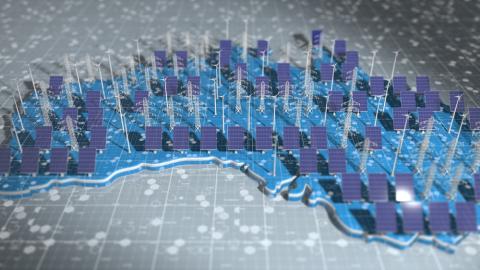
Key Findings
Despite an institutional consensus about the importance of renewables for Puerto Rico’s power grid, those in charge of day-to-day operation are pursuing aggressive plans for natural gas expansion.
IEEFA has documented a potential failure to achieve the commonwealth’s legislatively mandated renewable energy goals, which call for 40% renewable energy by 2025.
Puerto Rico’s renewable energy transformation is well under way, although it is entirely taking place at the level of individual households and businesses installing rooftop solar and storage.
The FOMB’s latest efforts to undermine rooftop solar are an example of poor management and poor planning that could dramatically slow the expansion of renewable energy in Puerto Rico.
Executive Summary
Puerto Rico residents and businesses have moved rapidly to install rooftop solar and storage in recent years to improve their resiliency in the face of an unreliable power system. These actions represent a bright spot in the transformation of Puerto Rico's electrical system towards more renewable energy. This report tracks the overall progress of Puerto Rico's long-touted transition to renewable energy—an effort that is behind schedule and plagued by major conflicts of interest.
There is a broad consensus among stakeholders on the need to transition to renewable energy:
- The Financial Oversight and Management Board (FOMB) of Puerto Rico has cited the importance of renewable energy to reduce vulnerability to volatility in fossil fuel prices. The utility cannot emerge from bankruptcy as a going concern with a balanced budget if its enterprise is wedded to the highly volatile operating environment caused by continued reliance on diesel, fuel oil and natural gas.
- In 2020, the Puerto Rico Energy Bureau approved a long-term plan for the utility that calls for a rapid expansion of solar and energy storage on the island. The bureau’s orders underscore the concern for affordable and reliable energy.
- The recently released U.S. Department of Energy (DOE) PR100 study attests to the technical feasibility of moving Puerto Rico to 100% renewable energy by 2050.
- The Puerto Rico Legislature, with the support of several governors, has supported the expansion of solar energy. In the island’s energy public policy law, Law 17-2019, the legislature acknowledged the urgency of the need for renewable energy expansion and recently made clear that it will continue to support greater investment in the renewable space.
Despite a sustained, multi-tiered institutional consensus that took years to develop, those in charge of the grid’s day-to-day operation are pursuing aggressive plans for natural gas expansion. The company in charge of power generation has a business model that is based on the creation, development and expansion of natural gas, utilizing a highly speculative investment strategy. The company, New Fortress Energy, recently told its investors that Puerto Rico’s future is natural gas. Recent transactions spearheaded by the company, with the approval of the island government, appear designed to lead to such a result.
The FOMB has also adopted a contradictory set of policies that undermine the expansion of renewable energy. Specifically, the FOMB is taking action to reduce “net metering” compensation, a critically important tool that has supported the widespread adoption of rooftop solar. This payment to customers for excess energy exported to the grid has been essential to the growth of rooftop solar, the only source of renewable energy that has been rapidly growing in Puerto Rico.
The Puerto Rico Electric Power Authority (PREPA) has embarked on a plan to develop new utility-scale solar energy, as mandated by the Puerto Rico Energy Bureau. Although initiated in 2020, no solar power generation has been installed under the utility-scale plan to date. The effort has been hampered by poor management and cost pressures.
This report documents a failure to achieve the commonwealth’s legislatively mandated renewable energy goals, which call for 40% renewable energy by 2025. Puerto Rico’s need to expand its renewable energy supply (which currently accounts for 9% of consumption) is widely accepted by the island’s residents, who are installing solar panels to provide resiliency in the face of the island’s dangerously unstable power system. Almost seven years after Hurricane Maria, Puerto Rico’s grid remains antiquated and unable to provide reliable service. As documented in this report, tens of thousands of individual households and businesses have been installing solar energy with battery backup for the past seven years, largely without the benefit of any direct subsidies, to have a reliable supply of electricity. This also represents an overwhelming vote of no confidence in the managers of the electrical system.
IEEFA offers a series of recommendations that can help to remedy some of the issues identified in this paper:
- PREPA should cancel its contract with Genera (a subsidiary of New Fortress Energy) as operator of PREPA’s power plants.
- The FOMB should allow the new Puerto Rico law to stand, extending net metering through 2030.
- The FOMB should consider several future forecasts of rooftop solar growth in its next fiscal plan to analyze and plan for the budgetary implications of different growth trajectories.
- The DOE should target future federally funded programs for rooftop solar and storage specifically for the most vulnerable households and support standardized, smaller systems to stretch federal dollars farther.
- The Puerto Rico Energy Bureau should track and publish metrics related to voltage stability at the distribution system level.
- LUMA, the private operator of Puerto Rico’s transmission and distribution grid, and the Puerto Rico Energy Bureau should publish up-to-date information on the hosting capacity of the distribution system and prioritize increasing hosting capacity where needed, ideally using available federal funds. Customers should not be responsible to pay for distribution system upgrades needed to integrate additional rooftop solar.
- The Energy Bureau should carry out a planning process, with ample community participation, for siting future utility-scale renewable energy projects, and all future procurement tranches should exclude protected agricultural lands and prioritize landfills, brownfields and degraded lands.
- An Independent Private Sector Inspector General (IPSIG) should be established to investigate the delays and cost overruns in the first group of solar projects approved by the Energy Bureau, and to make transparent, public recommendations for current and future procurement processes.
















